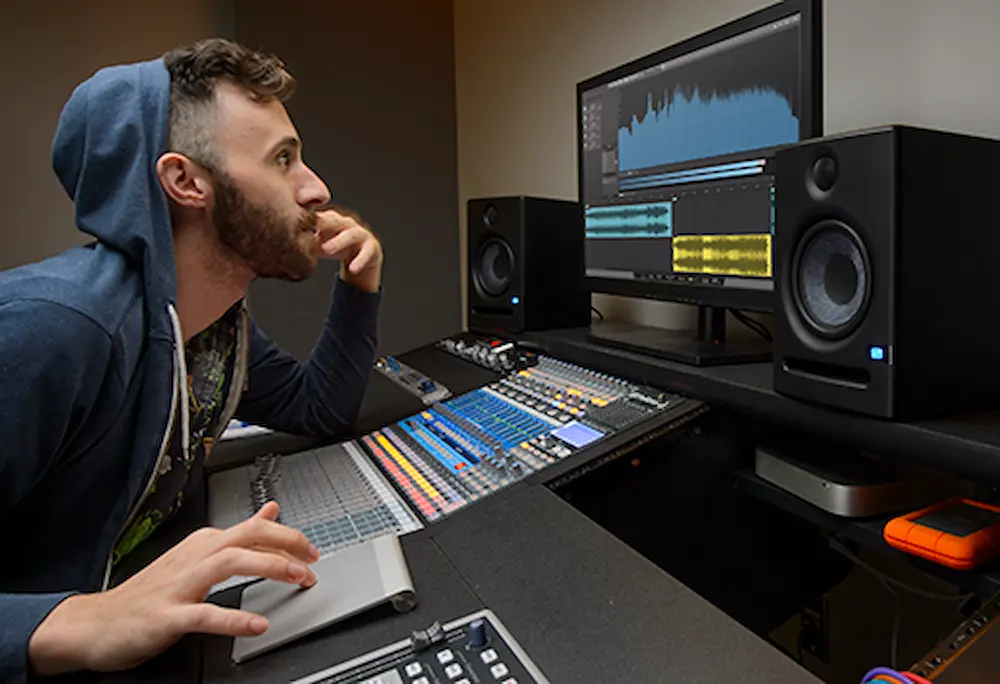Studio monitors are important tools used by mix engineers. They provide accurate sound details needed for critical mixing. Studio monitors come in different types, like active monitors with built-in amplifiers, and passive monitors that need external amplifiers. The size of the woofer in studio monitors affects the range and clarity of low sounds. Active studio monitors with built-in amplifiers and active crossovers are common today. Subwoofers are often used in modern studios to improve low-frequency range. Studio monitor management systems help engineers monitor mixes better. When choosing studio monitors, consider size, layout, and connectivity options for optimal sound reproduction.
The layout of Studio monitor, size considerations, placement in the room, and connection methods to computers or interfaces are crucial factors to consider when selecting the right studio monitors for your setup.
Best Studio Monitors
Selecting the ideal studio monitor requires considering your needs, like sound fidelity, budget, and purpose. Factors such as frequency range, accuracy, and room dimensions play a crucial role in choosing the right monitors for your setup.
JBL Studio Monitor
JBL Professional 305P MkII Next-Generation 5-Inch 2-Way Powered Studio Monitor
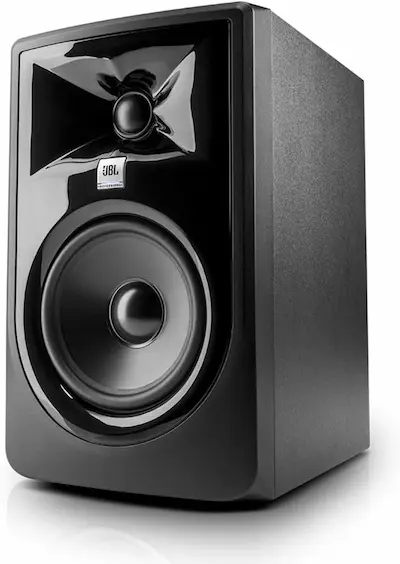
Studio engineers highly praise JBL monitors (Amazon) for delivering precise and accurate sound. These monitors are meticulously engineered to meet professional industry standards. The JBL Intonato 24 Studio Monitor Management Tuning System simplifies setup processes, complementing the 7 Series-based monitoring system. Reddit users share positive experiences with JBL monitors, highlighting sound quality and power output when compared to brands like KRK.
You can further look the whole range of JBL Studio Monitors from Amazon Studio Monitors listing.
Yamaha Studio Monitor
YAMAHA HS5 2-Way 70W Bass Reflex Bi-Amplified Studio Monitor (2-Pack) Bundle (2 Items)
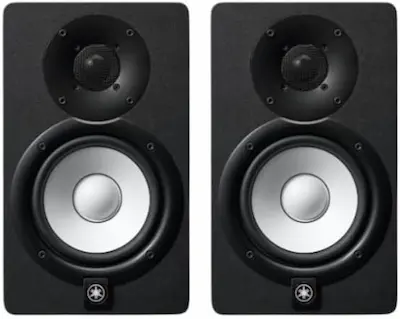
Yamaha Studio Monitors (Amazon) are renowned for their accuracy and precision, providing an honest sonic reference for audio professionals. Models like HS5, HS7, and HS8 from the HS Series have become industry standards for their faithful sound reproduction without added bass or treble frequencies. These monitors offer a transparent and reliable sonic platform for mixing and mastering tasks.
The Yamaha HS Series studio monitors are available as individual speakers or bundles with accessories like stands and cables. Users appreciate their accuracy, especially in small studios, although some feedback mentions a slight lack of bass response that can be addressed by adding a subwoofer for a fuller sound experience.
You can further look the whole range of JBL Studio Monitors from Amazon Yamaha Studio Monitors Listing.
KRK 5″ Classic Studio Monitor
KRK 5″ Classic Studio Monitor
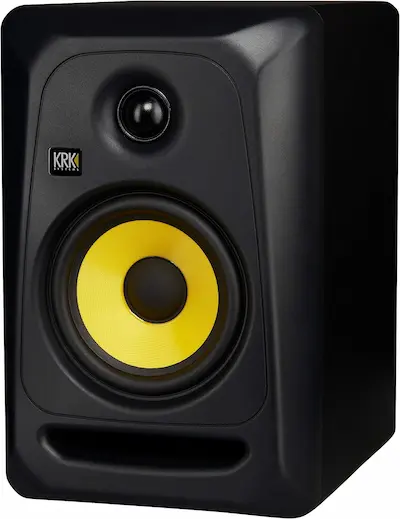
Some find KRK studio monitors (Amazon) good value, praising their affordability, flat response, and efficient class D amp. However, others prefer alternative brands like Kali or Adam Audio – which they believe offer superior low-end representation for mixing purposes. Views on KRK’s Rokit 5 Gen 4 monitors differ; some appreciate the features, others recommend other options.
You may also grab various variations from Amazon KRK Studio Monitors listing.
PreSonus Eris Studio Monitor
PreSonus Eris E4.5-2-Way 4.5″ Near Field Studio Monitor (Pair)
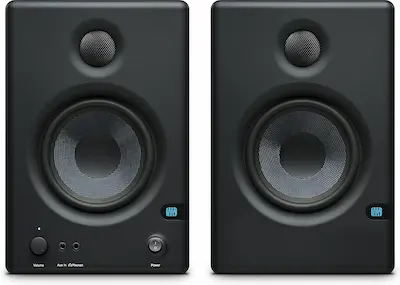
PreSonus Eris Studio (Amazon) Monitors offer precise sound reproduction. Their lineup includes Eris Studio 8, Eris Studio 4, and Eris E3.5. The Eris Studio 8 features an 8-inch 2-way design with an EBM waveguide for deep lows and clear highs. In contrast, the compact Eris E3.5 has Bluetooth, 3.5″ Kevlar low-frequency transducers, and 1″ silk dome tweeters for exceptional audio. Designed for studios, these monitors ensure accurate monitoring with acoustic tuning to optimize sound quality based on room acoustics.
You may have a choice to grab different models of Amazon PreSonus Studio Monitor listing
You may also like: Dell RGB Gaming Desktop Computer PC (intel core i5)
Most Important Features to Consider When Buying Studio Monitor
When purchasing studio monitor, several key things are important to think about. These ensure the best possible sound quality and performance:
Frequency Response
Frequency Response is the range of sounds a monitor can play. A wider range, from 20 Hz to 20 kHz, allows better balance in your mix. It helps avoid distortion too.
Power and Volume
Power and Volume matter a lot. More power means monitors can play loud without distorting. Higher power gives more dynamic range – this is key for precise mixing adjustments. Basic controls for volume, gain, EQ, and crossover are also crucial. These let you fine-tune the sound.
Room Adjustment and EQ
Room Adjustment and EQ help tune speakers to a room’s acoustics. While these features enhance quality, they can’t fix poor room acoustics alone. But in well-treated spaces, good room adjustment can significantly improve the sound.
Amplification
Amplification is very important. A quality amplifier complements studio monitors well. It should match the speakers’ power and dynamic range needs. Enough power delivery is vital for accurate sound reproduction.
Speaker Placement
Speaker Placement is key for accurate sound. Monitors should point towards the listener at an angle, forming an equilateral triangle with their head. This creates a “sweet spot” for the most precise frequency response and sound delivery.
Consider key features like response frequency, power/volume, room adjustment/EQ, amplification, and speaker placement. This allows informed decision-making when purchasing studio monitors. Monitors cater to audio recording and mixing needs effectively.
How to Connect Studio Monitor with Computer?
To hook up studio monitors to your computer, you have numerous choices based on your available ports. This guide will walk you through the setup based on provided details:
Connecting Studio Monitors to a Computer
- Plug the monitor into your computer’s appropriate input jack
- Next, set volume controls properly for ideal speaker-computer balance
- Test playback for any distortion heard
- If distortion occurs, tweak volumes until clear audio outputs
- After finding ideal settings, mute speaker volume controls
- Lastly, connect your headphones or extra speakers to the remaining cable end
- Ensure satisfactory audio through your headphones
Connecting to a Laptop
Linking a laptop requires easy steps:
- Insert one cable end into your laptop’s headphone jack, other in speaker
- Or directly attach 3.5 mm stereo miniplug to laptop headphone ports
Connecting to a Desktop Computer
- Use standard RCA connectors to connect your speakers to your desktop computer
- Consider buying a USB audio interface for multiple speaker connections
Connecting to a Mac
- Purchase an Apple Digital AV Adapter to connect your speakers to the digital outputs on your Mac
Using an Audio Interface
- An audio interface offers improved audio quality and additional inputs for microphones and instruments
- Connect your computer to the audio interface via USB cable and the interface to your speakers using balanced cables
By following these steps, you can effectively connect your studio monitors to your computer, ensuring optimal sound quality and performance.
What are the Advantages and Disadvantages of Larger Studio Monitors?
Advantages of Larger Studio Monitor
Bigger studio monitor, like ones with 8-inch speakers, have some benefits. One is they can do bass better because their bigger woofer cones move more air at low frequencies when turned up loud. They can also be more efficient at playing bass loudly by letting energy escape out the back through ports. Plus, larger monitors create fewer early reflections bouncing off nearby surfaces in a control room, making for a cleaner listening experience.
Disadvantages of Larger Studio Monitor
However, there are downsides to consider too with bigger studio monitors. They may not be well-suited for small rooms since their size can overwhelm the space, causing low frequency buildup and resonances. In less-than-ideal room setups, larger monitors make it tougher to mix accurately, especially for amateurs, because their powerful low-end oscillations are harder to manage and calibrate for faithful sound reproduction.
FAQ’s
What is the ideal size for studio monitors?
For a home studio, monitors between 5-8 inches are good. Their size depends on room size, preferred sound, and music type. Bigger woofers give lower bass. But they need bigger rooms to hear bass accurately. Small rooms suit small monitors. This prevents bass resonance and standing wave problems. The monitor size choice also depends on room acoustic treatment. It helps optimize monitor performance.
How do studio monitors compare to regular speakers?
Studio monitors are made with the goal of providing accurate and clear sound over the whole audio spectrum for professional audio recording, mixing, and mastering. These speakers are powered or active and have amplifiers built right in, giving you a clearer picture. Studio monitors are necessary equipment for mixing and mastering operations since, in contrast to ordinary home stereo speakers, they guarantee that errors and imperfections are not masked.
Can studio monitors be used for home entertainment?
Studio monitors get made for pro sound recording, mixing, mastering jobs. They aim for correct, clear playback of sounds. While monitors can work at home, they don’t make music more fun like home stereos. Monitors focus on accuracy and details, not boosting music enjoyment. So though monitors can play tunes at home, their job is really pro audio tasks and unbiased listening – not casual music vibes. Home stereo speakers better bring out musical thrills normal listeners prefer.
What are the differences between studio monitors and regular speakers?
Studio monitors are powered or active speakers with integrated amplifiers that provide accurate sound reproduction in various frequency ranges. They are appropriate for professional audio production and critical listening since they emphasis a flat, accurate sound for nearfield use. Conversely, regular speakers are passive devices that need an external amplifier to function. Their purpose is to raise the volume of audio by enhancing the bass or adding richness to the tones. Regular speakers are made for everyday listening pleasure, whereas studio monitors are best used in professional studios for audio recording, mixing, and mastering.

